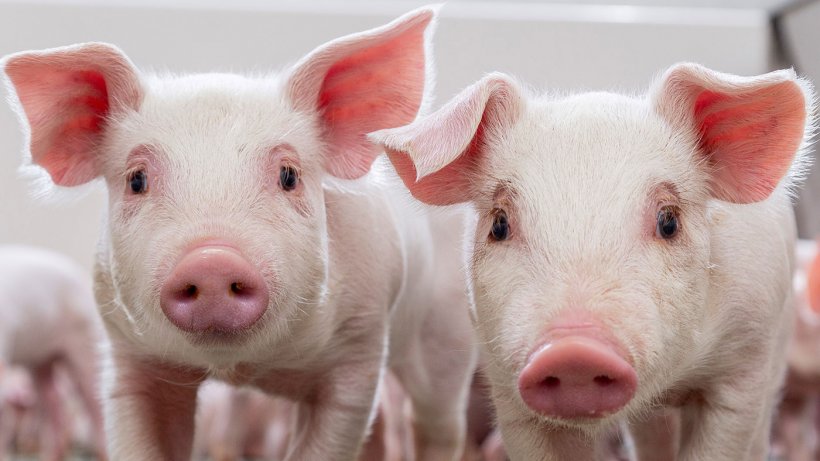PIGS! There’s Pooh’s best friend Piglet, in A.A. Milne’s Winnie-the-Pooh; Sesame Street’s glamorous Miss Piggy (of the lavender gloves); Warner Brothers’ stuttering Porky; and the spooky episode in Homer’s Odyssey, when the sorceress Circe turns Odysseus’s men into pigs. Taran, hero of Lloyd Alexander’s Chronicles of Prydain series, is an assistant pig-keeper, in charge of the visionary pig Hen Wen. Stalinist pigs Squealer, Napoleon, and Snowball take over George Orwell’s Animal Farm.
More pigs? Famous Pigs has detailed information on many famous pigs, both imaginary and real, with illustrations.
Table of Contents
PIG TALES
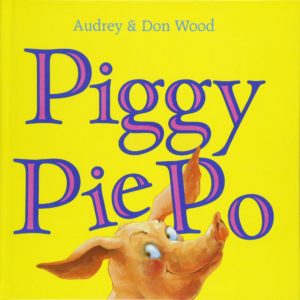
|
Audrey and Don Wood’s rhyming Piggy Pie Po (Harcourt Children’s Books, 2010) consists of three short and funny tales, variously about what a bouncy little pig wears (“When he wears his yellow coat/Piggy Pie Po likes to boat”), knows (“For a penny he will spell/Pistachio and pimpernel”), and eats (disastrously, a red-hot pepper). For ages 3-6. |
| See the Audrey Wood author page for information on the making of the book, a Piggy art show, and printable Piggy activity pages. | |
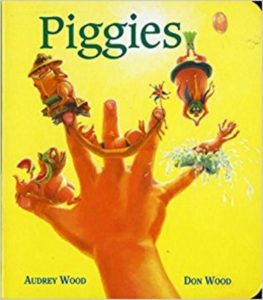
|
In Audrey and Don Wood’s Piggies (Sandpiper, 1995), a drove of hilarious and spectacularly inventive (sunbathers, bookworms, basketball players) pigs cavort on fingers and toes. For ages 3-6. |
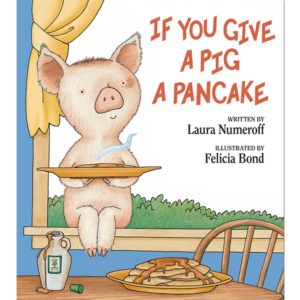
|
In Laura Numeroff’s If You Give a Pig a Pancake (HarperCollins, 1998), as in the now-near-classic If You Give a Mouse a Cookie (1985), a small beginning leads to complication after complication (the pancake leads to a demand for sticky maple syrup which leads to a need for a bubble bath which leads to a request for a rubber duck…). For ages 3-7. |
| Also see Numeroff’s If You Give a Pig a Party (HarperCollins, 2005). | |
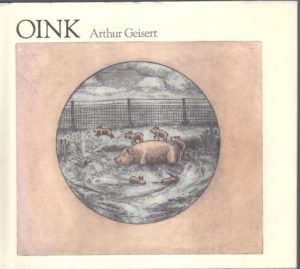
|
In Arthur Geisert’s Oink (Sandpiper, 1995) – illustrated in black and white and pink – a mother pig and her eight little piglets pass the day, all the action accompanied by the single word “oink,” delivered in several different tones of voice. Among them a furious OINK when mother pig discovers her piglets rampaging in the apple orchard. For ages 3-6. |
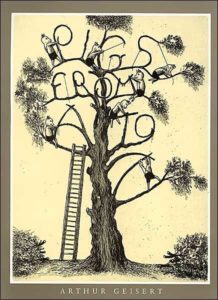
|
Arthur Geisert’s Pigs from A to Z (Sandpiper, 1996) is a wonderful (and wonderfully illustrated) twist on conventional alphabet books. As seven piglets build a treehouse, readers discover the many copies of letters hidden in the clever drawings on each page. For ages 3-6. |
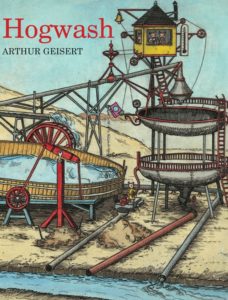
|
Arthur Geisert’s Hogwash (Houghton Mifflin Books for Children, 2008) is a marvelous mix of pig story and Rube Goldberg machine: the piglets are covered with mud, dust, and paint after a fun-filled day, so their mothers scrub them clean in an enormous bath machine, a contraption of tubs, chutes, pulleys, and cranks that will entrance any young engineer. For ages 3-7. |
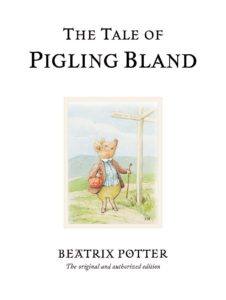
|
Beatrix Potter wasn’t all rabbits; two of her famous tales are about pigs: The Tale of Little Pig Robinson and The Tale of Pigling Bland (Frederick Warne, 2002). For ages 3-7. |
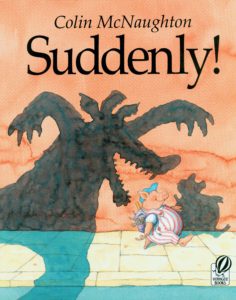
|
Do you remember Mr. Magoo – the massively myopic cartoon character who wandered blithely, blindly, and safely through disaster after disaster? In Colin McNaughton’s Suddenly! (Sandpiper, 1998), oblivious Preston the pig is being stalked by a menacing wolf – but each time, just as the wolf prepares to pounce, SUDDENLY something happens that allows Preston to escape. For ages 3-7. |
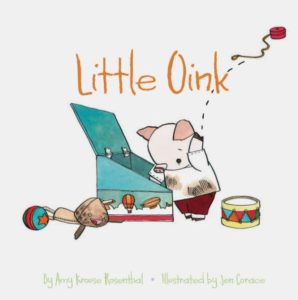
|
The title character of Amy Krouse Rosenthal’s Little Oink (Chronicle Books, 2009) is a very unusual little pig: he likes things neat, clean, and tidy. (“Mess up your room, put on some dirty clothes, and then you can go out and play,” said Mama Pig.) For ages 3-7. |
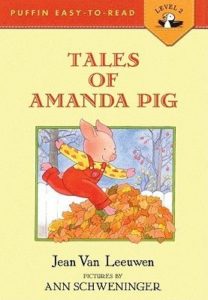
|
Jean Van Leeuwen’s Tales of Amanda Pig (Puffins Books, 1994) is a collection of short simple tales about Amanda, a pig all kids can relate to: she fights with her big brother Oliver, doesn’t like what her mother cooks for dinner, worries about an imaginary monster in the hallway, and doesn’t want to go to bed on time. There are many more titles in the Amanda Pig series, all easy readers dealing with the everyday activities of Amanda and Oliver. For ages 3-7. |
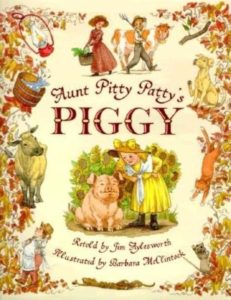
|
Jim Aylesworth’s Aunt Pitty Patty’s Piggy (Scholastic, 1999) is a folksy cumulative tale in which Aunt Pitty and niece Nelly – enlisting help from everyone in sight – try to convince their new pig to go through the gate into the farmyard. (“No, no, no, I will not go!”) For ages 3-7. |
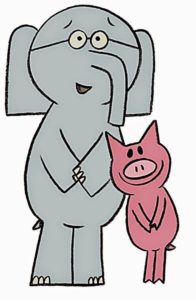
|
Mo Willems’s wonderful comic-book-style Elephant and Piggie series features two very different friends: Gerald, a down-to-earth elephant, and Piggie, an ebullient and over-optimistic pig. First of the series is Today I Will Fly! (Hyperion Books, 2007). Many sequels, all great. For ages 3-8. |
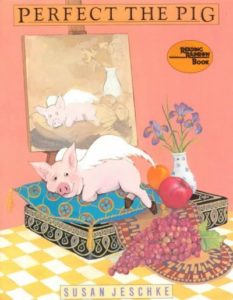
|
In Susan Jeschke’s Perfect the Pig (Henry Holt, 1996), Perfect – who does a good deed and is granted a wish for wings – survives a kidnapping and a stint as “The Great Flying Oink” to live happily ever after with his beloved guardian, Olive. For ages 4-7. |
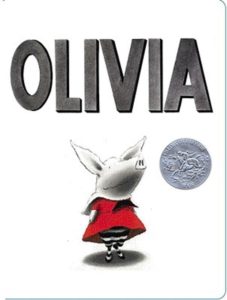
|
Ian Falconer’s Olivia (Atheneum, 2000) stars an adorable and irrepressible pig with a talent for singing loud songs, building sandcastles, and painting pictures on the walls. (And she’s very good at wearing people out.) Who doesn’t love Olivia? Many sequels. For ages 3-8. |
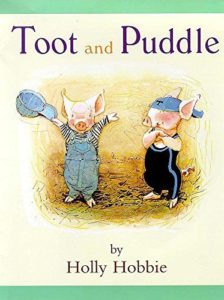
|
The main characters of Holly Hobbie’s Toot & Puddle (Little, Brown, 1997) are two enchanting little pigs: travel-minded Toot who roams all over the world, faithfully sending postcards home to Puddle, who doesn’t like to leave Woodcock Pocket. There are many sequels, throughout which Toot and Puddle, despite their differences, remain best friends. (Get a map, encourage your kids to draw postcards of their own, and you’ve got a great geography project here.) For ages 4-7. |
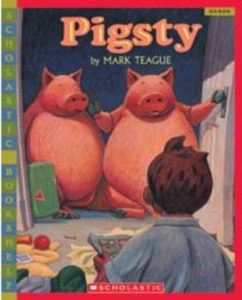
|
In Mark Teague’s Pigsty (Scholastic, 2004), Wendell’s despairing mother pronounces his room a pigsty and sends him upstairs to clean – where Wendell discovers a pig sprawled on his bed. The two new friends lead a happy and messy existence until more (and more) pigs arrive, and things get out of hand. Finally, driven to the wall, Wendell cleans – which drives the pigs back to the farm. For ages 4-7. |
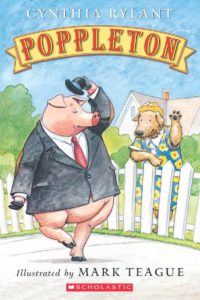
|
Cynthia Rylant’s Poppleton (Blue Sky Press, 1997) – a nice pick for beginning readers – is a short and funny chapter book starring Poppleton, a city pig who has relocated to the country, where he deals with an overly friendly neighbor (who plies him with oatmeal and toasted cheese), his need for privacy while reading, and a sick friend (a goat) who refuses to take his medicine. There are several Poppleton sequels. For ages 4-8. |
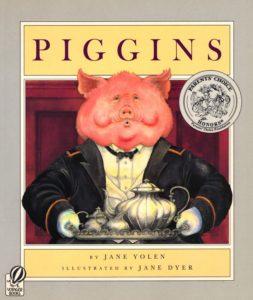
|
In Jane Yolen’s picture book Piggins (Sandpiper, 1992), the Reynards have thrown an elegant dinner party to show off Mrs. Reynard’s new diamond necklace. Then the lights go out – and when they come on again, the necklace (horrors!) is gone. Luckily Piggins, the Reynards’ savvy and elegant butler, is able to follow the clues to identify the culprit. For ages 4-8. |
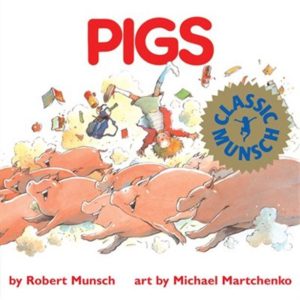
|
In Robert Munsch’s Pigs, Megan’s father asks her to feed the pigs, but warns her not to open the gate. (“Pigs are smarter than you think.”) Megan promises not to – but she does. And the pigs are. For ages 4-8. |
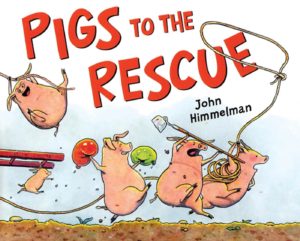
|
In John Himmelman’s Pigs to the Rescue (Henry Holt and Company, 2010), eight excitable pigs (“Pigs to the rescue!”) solve (well, more or less) a multitude of problems on the Greenstalk farm. For ages 4-8. |
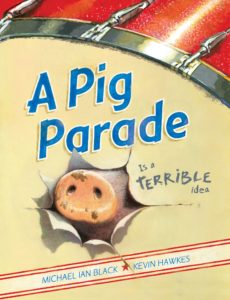
|
“Like most children,” begins Michael Ian Black’s A Pig Parade Is a Terrible Idea (Simon & Schuster Books for Young Readers, 2010), “you have probably thought to yourself at one time or another, I bet a pig parade would be a lot of fun.” Well, the author quickly points out, forget it: pigs won’t march (they prefer to snuffle); they refuse to wear majorette uniforms; and the only floats they’re interested in involve root beer. Great pictures by Kevin Hawkes and a deadpan delivery make this a hoot for ages 4-8. |
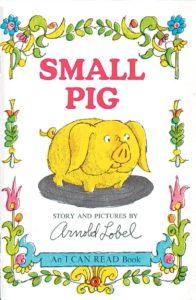
|
Arnold Lobel’s Small Pig (HarperCollins, 1988), an I Can Read Book, is the simple (but clever) story of a floppy-eared little pig who likes nothing better than to wallow in his mud puddle. When the farmer’s wife goes on a cleaning spree, he runs away and finds what he thinks is a new mud puddle in the city – which, disastrously, turns out to be a patch of soft cement. For ages 4-8. |
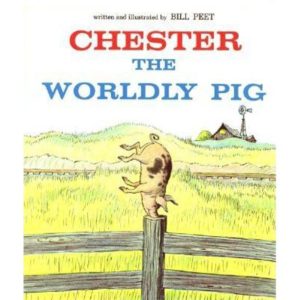
|
In Bill Peet’s Chester the Worldly Pig (Houghton Mifflin, 1978), Chester (who can stand on his snout) becomes a circus star. For ages 4-8. |
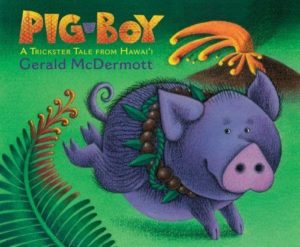
|
Gerald McDermott’s Pig-Boy (Houghton Mifflin Harcourt, 2009) is a re-telling of a traditional trickster tale from Hawaii in which Pig-Boy – shown as a cheerful purple pig – manages to slither out of trouble by using shape-shifting magic. For ages 4-8. |
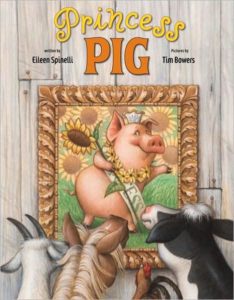
|
The theme of Eileen Spinelli’s Princess Pig (Knopf Books for Young Readers, 2009) is “To thine own self be true.” When a Princess sash from the county fair beauty pageant blows away and lands on Pig, she begins to wonder if she might truly be a princess after all. Despite protests from her barnyard friends, she revels in her new princess status, acquiring a crown (a tea cup), jewels (a daisy-chain necklace), and – via a roll in the honeysuckle – a princess-like smell. But it turns out that life as a princess isn’t as fun as expected, and finally Pig takes Pony’s advice (“there’s nothing wrong with being a pig”) and returns happily to her friends on the farm. For ages 4-8. |
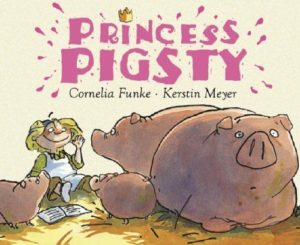
|
In Cornelia Funke’s Princess Pigsty (The Chicken House, 2007), Princess Isabella is sick of being pretty, proper, and pampered, and she doesn’t want to wear a crown. In fact, she wants to get dirty. Her harried father sends her to work in the pigsty as punishment, where Isabella finds that she enjoys the pigs. Finally her father, who misses her, coaxes her back to the palace with a promise of more freedom, and the book closes with a dirty and delighted Isabella, crownless and in pants. For ages 5-8. |
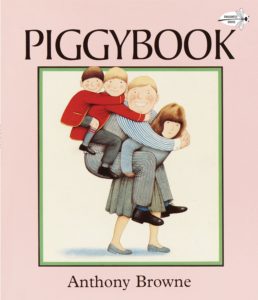
|
In Anthony Browne’s Piggybook (Dragonfly Books, 1990), the overworked and underappreciated Mrs. Piggott abandons her slovenly husband and sons, leaving behind a note reading “You are pigs.” Left on their own, man and boys are unable to cope and soon all three of them – literally – turn into pigs. Finally Mrs. Piggott returns, and her family is only too glad to accept her re-assignment of chores. For ages 5-8. |
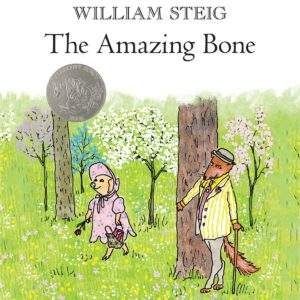
|
In William Stieg’s The Amazing Bone (Square Fish, 2011), Pearl – a perfect charmer of a pig in a pink dress and sunbonnet – discovers a magical talking bone that helps her fend off masked bandits and a hungry fox. For ages 5-8. |
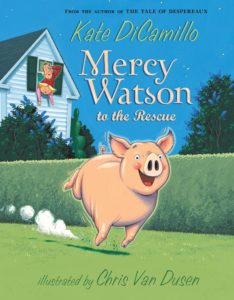
|
The main character of Kate DeCamillo’s Mercy Watson to the Rescue (Candlewick, 2009) is Mercy Watson, pampered pet pig, fond of buttered toast – who, via a series of accidents, manages to save the day. Many chaotic sequels for ages 6-9. |
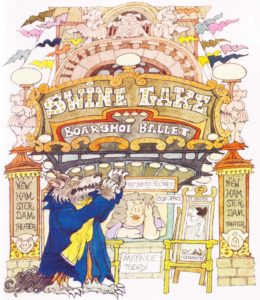
|
By James Marshall, with illustrations by Maurice Sendak, Swine Lake (HarperCollins, 1999) is a tongue-in-cheek delight. The wolf arrives at the all-pig Boarshoi Ballet’s performance of Swine Lake, prepared to leap on the stage and nab a tasty porker – but he’s so enthralled by the performance that instead he sits through the whole thing, and even spends his last penny on a ticket to the next night’s performance. For ages 6-10. |
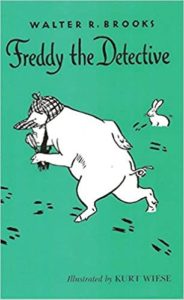
|
Walter R. Brooks’s 26 Freddy the Pig books, originally written in the 1930’s and 40’s, all feature Freddy, a versatile, poetic, and hilarious pig, and his animal friends on the Bean farm. Freddy is always ready to try something new; while he and his friends struggle to deal with the wicked schemes of Simon and his gang of rats, Freddy variously tries his hand at being a detective, explorer, politician, magician, pilot, and cowboy. In Freddy the Detective (Overlook Juvenile Books, 2010), Freddy discovers Sherlock Holmes and promptly sets out to emulate his new hero, solving assorted mysteries involving a stolen toy train, a missing bunny named Egbert, and a false charge of murder. For ages 7-11. |
| Freddy the Pig’s Home Page has synopses of all the Freddy books, more information on Freddy and the Bean farm, illustrations, and a biography of Walter R. Brooks. Visit the site and become an official Friend of Freddy. | |
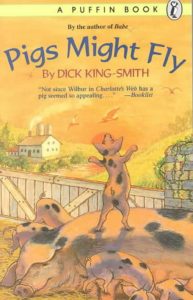
|
In Dick King-Smith’s Pigs Might Fly (Puffin, 1990), Daggie Dogfoot, the runt of Mrs. Barleylove’s litter, is born with peculiar dog-like feet, and narrowly escapes being taken away by the farmer, known to the pigs as the Pigman. Though he tries his best to learn to fly, instead dauntless Daggie learns to swim, with help from friends Felicity (a duck) and Isaak (an otter). He puts his talent to use when the Pigman and the other pigs are trapped by a flood. A story of hope, determination, and triumph over obstacles for ages 7-11. |
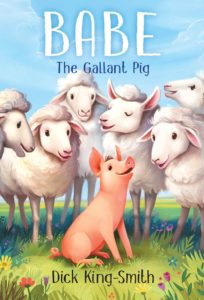
|
In Dick King-Smith’s Babe: The Gallant Pig (Yearling, 1995): gentle and soft-spoken Babe, raised by Farmer Hoggett’s sheepdog Fly, is determined to become a sheep-herder in turn. Nobody believes a pig can do it, until Babe – a good negotiator if there ever was one – triumphs in the National Sheepdog Trials. A sequel, Ace, the Very Important Pig (Yearling, 1992) stars Babe’s highly intelligent great-grandson. For ages 7-11. |
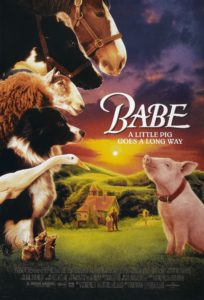
|
The 1995 movie version of Babe: The Gallant Pig is loved by practically everybody. Rated G. |
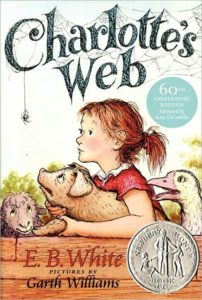
|
In E.B. White’s Charlotte’s Web (HarperCollins, 2006), originally published in 1952, Charlotte, the wise spider, befriends Wilbur, a sweetheart of a pig, and saves his life by weaving messages in her web (“Some Pig”). For ages 7-12. |
| From Web English Teacher, the E.B. White: Lesson Plans page has lesson plans, online quizzes, discussion guides, and activities to accompany Charlotte’s Web. | |
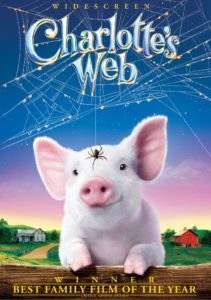
|
Film versions of Charlotte’s Web include the 2006 movie, with Dakota Fanning as Fern, and Julia Roberts as the voice of Charlotte; and the 1973 animated movie, with Debbie Reynolds as Charlotte. |
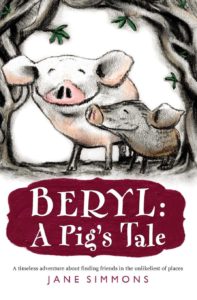
|
In Jane Simmons’s Beryl: A Pig’s Tale (Little, Brown Books for Young Readers, 2011), Beryl is wrenched from her family and sent on a truck to market. She escapes and finds friends among the wild pigs – though prejudice soon forces her and her adopted family to leave the community and look for a new home – encountering en route the Sisterhood of the Mystic Boar (who proclaim Beryl the “Chosen One”). For ages 8-12. |
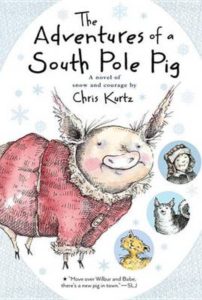
|
In Chris Kurtz’s The Adventures of a South Pole Pig (Harcourt Children’s Books, 2013) (“a novel of snow and courage”), feisty Flora has been raised on a farm with sled dogs, and is determined to become a sled pig. She ends up on a ship to Antarctica where she becomes friends with the ship’s cat and learns to catch rats – and when the crew is shipwrecked and stranded, Flora’s brains and talent save the day. For ages 8-12. |
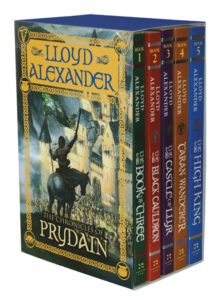
|
Lloyd Alexander’s Newbery-winning Chronicles of Prydain (Square Fish, 2006), originally published in 1964, is a five-book fantasy series based on Welsh mythology. Titles are The Book of Three, The Black Cauldron, The Castle of Llyr, Taran Wanderer, and The High King. The hero of the series is Taran, the Assistant Pig-Keeper, charged with the care of the oracular white pig, Hen Wen, who holds the secret to the destruction of Arawn Death-Lord and the evil Horned King. For ages 9 and up. |
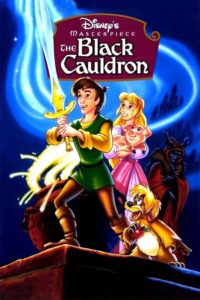
|
A Disney animated movie, The Black Cauldron (1985), is based on the first two books of the series. Rated PG. |
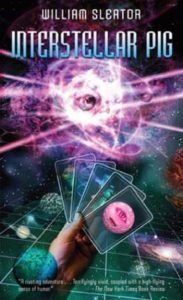
|
In William Sleator’s Interstellar Pig (Puffin, 1995), Barney, on vacation, meets neighbors who invite him to play a strange role-playing game called Interstellar Pig. It turns out that the neighbors are aliens and the game is a battle for the survival of Earth. For ages 9-12. |
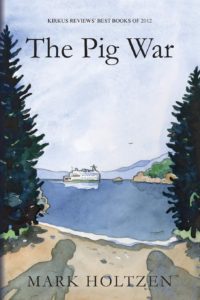
|
In Mark Holtzen’s The Pig War (CreateSpace, 2012), Kell and his full-of-beans little sister Grace (who wears a red satin cape) are sent to spend the summer with their grandfather in his cabin on remote Mowbray Island in the Pacific Northwest. Kell expects a terrible experience – until he discovers a pistol and diary dating to the mid-19th century Pig War, a boundary dispute between the U.S. and Canada. Suspense, adventure, some little-known history, and rewarding relationships for ages 10 and up. |
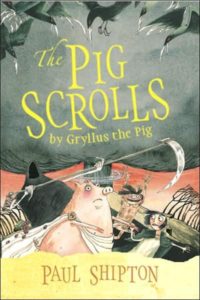
|
Paul Shipton’s The Pig Scrolls (Candlewick, 2007) is narrated by Gryllus, once one of Odysseus’s shipmates, now – thanks to Circe – an enchanted talking pig with a snarky sense of humor. (“Learn a proper trade,” he tells teenage poet Homer. “Like plumbing.”) He’s quite happy being a pig – but greater things are in store, since a junior prophetess named Sybil has just discovered that he’s destined to save the cosmos from Thanatos, the god of death. A riotous read for ages 10-14. |
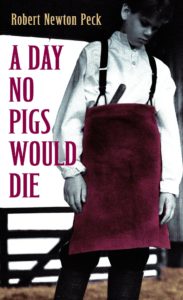
|
Robert Newton Peck’s A Day No Pigs Would Die (Laurel Leaf, 1990) is a coming-of-age book set in rural Vermont in the 1930’s, centering around young Robert; his illiterate father, Haven, a pig butcher; and Robert’s pig Pinky – a gift from a neighboring farmer after Robert saved the farmer’s calf. The book is superbly written, and deals well with a number of difficult issues. For ages 12 and up. |
| From Web English Teacher, A Day No Pigs Would Die has lesson plans, reading guides, and vocabulary lists to accompany the book. | |
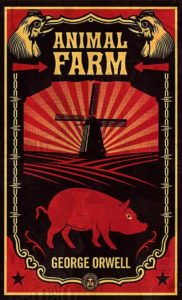
|
George Orwell’s Animal Farm (available in many editions) is a now-classic political fable in which the animals of Manor Farm, led by the pigs Snowball and Napoleon, overthrow their human owners and establish a new regime dedicated to fairness and equality. As the book progresses, however, the now re-named “Animal Farm” becomes increasingly totalitarian and eventually the pigs take the place of the animals’ former human masters. The complete text of Animal Farm is available online. For ages 12 and up. |
| In the 1999 film version of Animal Farm, directed by John Stephenson, pigs Snowball, Squealer, and Napoleon are respectively voiced by Kelsey Grammar, Ian Holm, and Patrick Stewart. Rated PG. | |
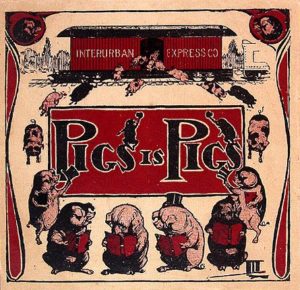
|
The classic story Pigs Is Pigs – written by Ellis Parker Butler in 1905 – actually deals with guinea pigs. The premise: after an argument over railway rates for shipping two guinea pigs, a railway agent ends up temporarily housing the pigs, during which time they (geometrically) reproduce. It’s funny. And there’s math. |
| Charles Lamb’s Dissertation on Roast Pig is a tongue-in-cheek essay on the origin of roast pig. According to Lamb, the dish originated in China, when a swineherd’s son named Bobo inadvertently burned his house down, with a litter of pigs inside. |
